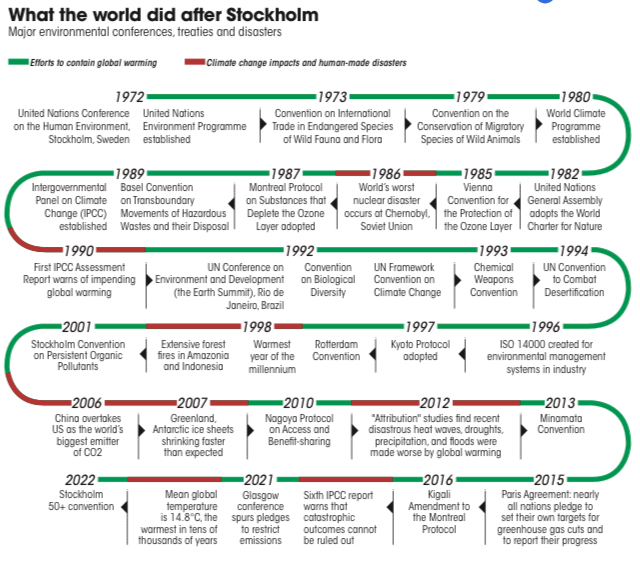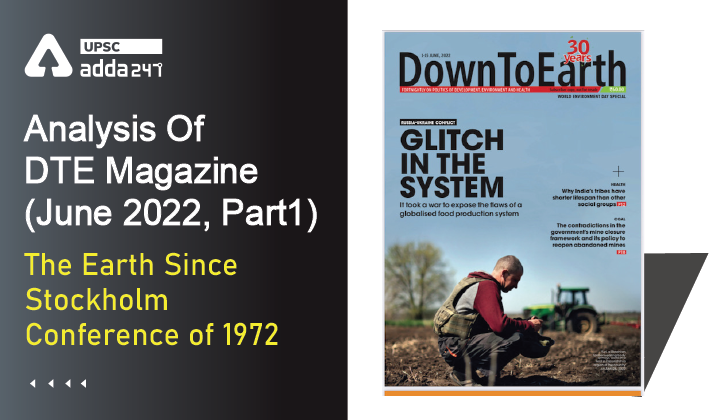Table of Contents
Analysis Of Down To Earth Magazine: The Earth Since Stockholm Conference of 1972
Introduction
- It has been 50 years since the Stockholm Conference of 1972, but the environmental problems are only increasing.
- By 2050, the world needs to produce at least 50 per cent more food to feed the projected global population of 10 billion people.
About Stockholm Conference of 1972
- Stockholm Conference of 1972 was the first worldwide convergence on planetary environment, with the theme “Only One Earth”.
- The participating 122 countries—70 of them developing and poor countries—adopted the Stockholm Declaration on June 16, 1972.
- They essentially committed to 26 principles and an action plan that set in a multilateral environmental regime.
- This was the first globally subscribed document that recog- nised the “interconnections between development, poverty and the environment.”
- The three dimensions of this conference were: countries agreeing not to “harm each other’s environment or the areas beyond national jurisdiction”; an action plan to study the threat to Earth’s environment; and establishment of an international body called the UN Environment programme (unep) to bring in cooperation among countries.
What has been changed since Stockholm Conference?
- The Stockholm Conference of 1972 had put environmental issues on the global agenda for the first time.
- Today, over 176 countries have environmental framework laws; 150 countries have enshrined environmental protection or the right to a healthy environment in their constitutions; and 164 countries have created cabinet-level bodies responsible for environmental protection, as per the United Nations.
World population
-
- From about 3.85 billion people in 1972, the global population has increased to 7.8 billion in 2022.
- The world population will continue to grow, the average age will increase, populations will become more urban, and household sizes will become smaller.

Air
-
- Globally, the highest annual average concentrations of PM 2.5 are seen in areas affected by windblown sand and dust (northern Africa and west Asia), fires (central Africa and Latin America) and anthropogenic pollution (south and east Asia).
- Cities with the highest levels were clustered in east-central China and the Indo-Gangetic Plain
PM 2.5 exposure
- Even in 2050, a perceptibly high population of the wold will continue to remain exposed to PM2.5, which remains the highest environmental risk factor for global burden of distance.
Biodiversity
The world saw an average 68 per cent decrease in population sizes of mammals, birds, amphibians, reptiles and fish between 1970 and 2016, suggesting that biodiversity is being destroyed by humans at an unprecedented rate.
Biodiversity loss
Conservation is critical but not enough to restore biodiversity loss.
Land Use
- Agriculture and food production are still responsible for most of the changes of land use, including forests and other types of ecosystems.
Land /Soil Degradation
- Human-induced land degradation remains a fundamental environmental problem affecting food security, livelihoods and lives of the people.
Conclusion
The world now needs to also transform food production and consumption patterns. Such a transformation would also provide large co-benefits for the environment, through reduced greenhouse gas emissions, fertiliser application and irrigation water consumption.
Also Read: Analysis Of DTE Magazine: Stockholm+50



 TSPSC Group 1 Question Paper 2024, Downl...
TSPSC Group 1 Question Paper 2024, Downl...
 TSPSC Group 1 Answer key 2024 Out, Downl...
TSPSC Group 1 Answer key 2024 Out, Downl...
 UPSC Prelims 2024 Question Paper, Downlo...
UPSC Prelims 2024 Question Paper, Downlo...





